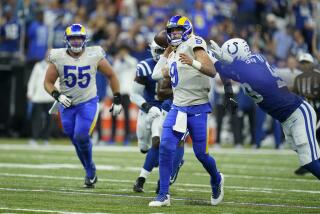If the Patriots make size matter, Colts could be in trouble
- Share via
The strategy against the Indianapolis Colts’ defense has always been pretty simple:
Score first and then pound on the Colts’ undersized unit until it breaks.
It’s a game plan that worked for the Pittsburgh Steelers in the playoffs a year ago, but a formula that failed Kansas City and Baltimore in the first two rounds of these playoffs.
Regarded as the team’s weak link heading into the postseason, defense is the main reason Indianapolis will play host to its first AFC championship game, against the New England Patriots, on Sunday.
With Peyton Manning making mistakes like a rookie quarterback, Indianapolis needed defense to defeat the Chiefs and Ravens.
Manning had a 101.0 quarterback rating in the regular season, but is at 58.3 in the postseason because of five interceptions with only one touchdown pass. During the regular season, he passed for 31 touchdowns with nine interceptions.
While Manning has struggled, the Colts’ defense has turned the tables toward the positive.
It has limited teams to 3.4 yards a carry after giving up 5.3 during the regular season. And on third down, playoff opponents have converted only 13.6% (three of 22 opportunities), down from 47% (90 of 191).
No defense in the NFL relies more on speed than the Colts, who start smaller-than-average players at nearly every position. To compensate for their lack of size, Indianapolis defenders use quickness to make plays from sideline to sideline, which is easier to do on the fast, artificial surface of the RCA Dome.
Just look at the Colts defensive backs, a group that would dominate in a six-foot and under league: Rookie safety Antoine Belthea is the biggest player in the secondary, and he’s only 5 feet 11, 203 pounds. Cornerbacks Jason David and Nick Harper are both shorter than 5-10, and safety Bob Sanders is a 5-8 sparkplug.
Indianapolis’ linebackers are also small, averaging 6 feet and 230 pounds, and the Colts’ defensive line is led by ends Dwight Freeney and Robert Mathis, two disruptive undersized players who dominate with their speed around the edges.
Freeney and Mathis each has been timed running the 40-yard dash under 4.4 seconds, which is unheard of for a lineman. Their ability to pressure quarterbacks forces opponents to use tight ends and running backs to help in pass protection, which opens things up for Indianapolis’ speedy linebackers.
Against offense-challenged Kansas City and Baltimore, the Colts did not have problems dictating down and distance situations. Indianapolis scored first and then had easy times shutting down the Chiefs and Ravens’ ground attacks because they lacked formidable passing games.
That will be much more difficult against Tom Brady and the Patriots, pursuing their fourth Super Bowl title in six years.
Although New England has quality running backs in Corey Dillon and Laurence Maroney, do not be surprised if Brady attacks the Colts out of a spread shotgun formation early in the game.
That’s how the Steelers took a lead en route to beating Indianapolis in last year’s playoffs, and Brady has excelled directing similar schemes in previous postseason games -- including much of the fourth quarter of New England’s victory over San Diego last week.
Summary: Although the Colts are 9-0 at home in the RCA Dome this season, several teams had success moving the ball against them. For New England to do it, the Patriots need wide receivers such as Reche Caldwell and Jabar Gaffney to play well. The Colts defensive backs may be short, but they play tough and physical. It will be interesting to see how well New England’s wideouts match up against an Indianapolis secondary that has not been tested during the playoffs.
*
More to Read
Go beyond the scoreboard
Get the latest on L.A.'s teams in the daily Sports Report newsletter.
You may occasionally receive promotional content from the Los Angeles Times.










